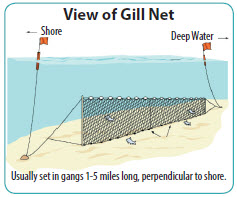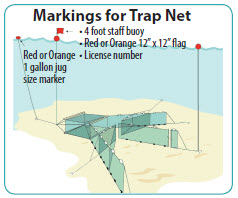

Great Lakes' anglers and boaters may encounter commercial trap nets, gill nets and hook lines. All state-licensed or Native American commercial gear are marked with floats and or staff/flag combinations. Please give wide berth to any markers, since anchor lines may extend several hundred feet in any direction from the floats or flags and along the length of the gear.
Do not tamper with commercial fishing gear; it's illegal. Removal or destruction of marker buoys and flags or other disturbance of gear often results in the waste of a valuable resource, since the nets continue to catch fish. They can also create safety problems for others on the water.


Viral Hemorrhagic Septicemia virus (VHSv), which does not affect humans in any way, is a fish disease first confirmed in the Great Lakes in 2005 when it caused a large fish kill in Lake Ontario. The disease was brought here by ballast water from large freighters between 2000-2002. Currently, it appears to have a very spotty distribution in Michigan. It has been detected in two inland lakes in Clare and Washtenaw Counties. The virus has been detected in 25 fish species in the Great Lakes region, including walleye, muskellunge, largemouth bass, bluegills, black crappie, Chinook salmon, whitefish, freshwater drum and gizzard shad. VHSv has never been found in any state fish hatchery. Fishing regulations are in effect to reduce the spread of this viral pathogen. See the Michigan Fishing Guide for complete details.